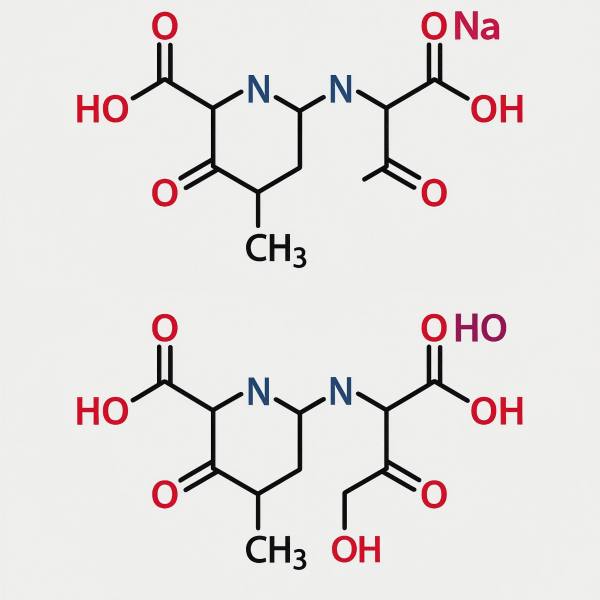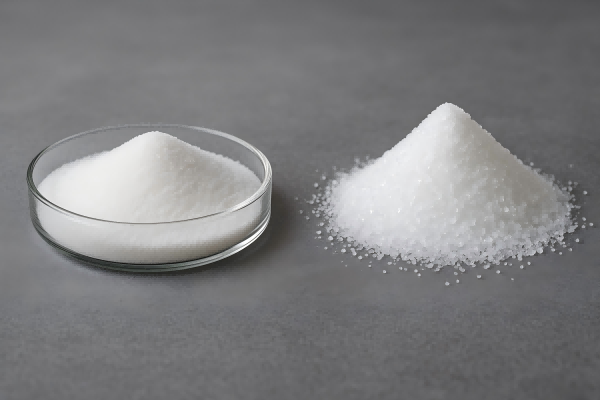A common chelating agent, ethylenediaminetetraacetic acid (EDTA) binds metal ions and enhances stability, solubility, and performance in a variety of sectors, including food processing, water treatment, cosmetics, and pharmaceuticals.
However, EDTA is rarely used in its pure acid form due to its poor solubility in water. Instead, it is commonly applied as one of its salt forms—EDTA Disodium Salt (EDTA-2Na) and EDTA Tetrasodium Salt (EDTA-4Na). These two variants have different chemical properties, applications, and performance characteristics.
As a chemical raw material supplier, we recognize that selecting the appropriate EDTA salt can greatly influence the outcome of a formulation or manufacturing process. In this article, we’ll explore the fundamental differences, similarities, and industrial relevance of EDTA Disodium Salt vs. Tetrasodium Salt in detail.
Chemical Composition and Structure
EDTA Disodium Salt (EDTA-2Na)
- Chemical Name: Disodium ethylenediaminetetraacetate
- Molecular Formula: C₁₀H₁₄N₂Na₂O₈·2H₂O
- Molar Mass: ~372.24 g/mol (dihydrate form)
- Appearance: White crystalline powder
- pH (1% solution): ~4.5 – 5.5
- Solubility: Moderate in water
EDTA Tetrasodium Salt (EDTA-4Na)
- Chemical Name: Tetrasodium ethylenediaminetetraacetate
- Molecular Formula: C₁₀H₁₂N₂Na₄O₈
- Molar Mass: ~380.17 g/mol
- Appearance: White to off-white powder or granules
- pH (1% solution): ~10 – 11.5
- Solubility: High in water
Structural Similarity
Both are salts of the parent acid EDTA, which has four carboxyl (-COOH) groups and two amine groups (-NH₂) capable of forming six coordinate bonds with metal ions, making them powerful chelators. The number of hydrogen atoms in the acid that have been swapped out for sodium ions is what makes a difference.
- EDTA-2Na: 2 sodium ions → mildly acidic solution
- EDTA-4Na: 4 sodium ions → strongly alkaline solution
pH and Buffering Capacity
EDTA-2Na: Mildly Acidic
With a solution pH around 4.5–5.5, EDTA-2Na is commonly used in formulations where neutral to slightly acidic conditions are desired. It is preferred in personal care products like shampoos, creams, and cleansers where extreme alkalinity would be irritating or unstable.
EDTA-4Na: Strongly Alkaline
EDTA-4Na has a much higher pH of 10–11.5. It acts as a buffering agent in alkaline formulations, making it ideal for industrial cleaning, metal surface treatment, and detergent formulations. However, it is generally not suitable for formulations requiring pH control below 7.
Chelating Strength and Metal Ion
Sequestration
EDTA salts are used primarily for their ability to chelate (bind) metal ions like Ca²⁺, Mg²⁺, Fe³⁺, and heavy metals such as Pb²⁺ or Hg²⁺.
Metal Binding
Both EDTA-2Na and EDTA-4Na have similar chelating capacity, with the main difference lying in reaction conditions rather than fundamental sequestration ability. Once dissolved in water and adjusted for pH, they both form stable complexes with metal ions.
Chelation Efficiency in Practice
- EDTA-2Na is more effective in neutral to acidic solutions
- EDTA-4Na performs better in alkaline environments, such as industrial cleaning agents or alkaline degreasers
Solubility and Preparation
EDTA-2Na
EDTA-2Na is moderately soluble in water (~100g/L at 20°C). However, in acidic media, the solubility decreases, and precipitation may occur if the pH drops too low.
EDTA-4Na
EDTA-4Na has significantly higher water solubility, making it easier to handle in large-scale applications. It dissolves quickly and is ideal for aqueous systems requiring rapid metal sequestration.

Industrial Applications: Side-by-Side Comparison
| Application | EDTA Disodium Salt (2Na) | EDTA Tetrasodium Salt (4Na) |
| Cosmetics & Personal Care | Stabilizes emulsions, prevents rancidity | Occasionally used in alkaline personal care cleansers |
| Detergents & Cleaning Agents | Mild formulations for surfaces, fabrics | Strong alkaline detergents, degreasers, dishwashing |
| Water Treatment | Chelates Ca²⁺/Mg²⁺ in neutral pH systems | Preferred in high-pH boilers and cooling towers |
| Pharmaceuticals | pH-sensitive drug stabilization | Rare due to alkalinity |
| Food Industry (E-number: E385) | Preserves color in canned food (allowed in some regions) | Not suitable due to alkalinity |
| Textile & Dyeing | Prevents dye fading, improves binding | Strips metal residues from equipment and fabrics |
| Metal Plating & Electroplating | Buffering and metal ion sequestration at lower pH | Enhances stripping and cleaning of metal surfaces |
| Paper & Pulp Industry | Controls scale and metal contaminants | Used for boiler descaling |
Regulatory and Safety Considerations
Cosmetic and Food Grade Compliance
- EDTA-2Na is widely accepted in cosmetics and food applications (under restricted conditions and concentrations). It’s generally regarded as safe (GRAS) when used appropriately.
- EDTA-4Na, due to its high pH, is generally not permitted in food or near-neutral cosmetic formulations unless thoroughly neutralized and justified by safety data.
Toxicity and Biodegradability
- Both salts exhibit low acute toxicity, but are poorly biodegradable in the environment.
- Regulatory agencies often limit discharge concentrations in wastewater due to potential persistence and interference with metal ions in natural ecosystems.
Appropriate handling practices include use of gloves, safety goggles, and protective clothing. Keep out of the reach of acids and oxidizers by storing in sealed containers.
Cost and Storage Considerations
Price Comparison
In general, EDTA-2Na tends to be slightly more expensive due to higher purity demands in cosmetic and pharmaceutical applications.
EDTA-4Na is more cost-effective for industrial-scale use where high alkalinity is needed, and purity can be slightly lower.
Storage Recommendations
Both salts should be stored in cool, dry, and ventilated environments, away from acids (which could release harmful gases when reacting with EDTA salts).
Practical Selection Guide
To help industrial formulators, chemists, and buyers choose the appropriate EDTA salt, consider the following table:
| Criterion | Use EDTA-2Na If… | Use EDTA-4Na If… |
| Target pH is below 7 | ✔️ Needed | ❌ Not recommended |
| Formulation is neutral | ✔️ Compatible | ❌ May require neutralization |
| Alkaline formulation | ❌ Limited efficiency | ✔️ Highly effective |
| Product touches human skin | ✔️ Preferred for mildness | ❌ High pH could irritate skin |
| Application is food-grade | ✔️ Complies with some regulations | ❌ Generally restricted |
| Used in metal cleaning | ❌ Less aggressive | ✔️ Strongly effective at high pH |
| Rapid dissolution needed | ❌ Requires time | ✔️ High solubility |
| Budget constraints | ❌ Often costlier | ✔️ Economical in bulk |
Real-World Examples
EDTA-2Na in Cosmetics
In a skin cream, EDTA-2Na stabilizes the product by chelating trace metal ions (like iron or copper) that can catalyze rancidity. It also enhances preservative efficacy by binding metal ions that would otherwise inactivate preservatives.
EDTA-4Na in Industrial Detergents
A heavy-duty alkaline floor cleaner may use EDTA-4Na to chelate hard water ions (Ca²⁺/Mg²⁺) and prevent soap scum or scale buildup. Its strong alkalinity enhances degreasing power and is preferred in commercial cleaning applications.
As a chemical raw material supplier, we recommend that formulators carefully consider pH requirements, solubility, safety, and end-use applications before choosing between these two forms of EDTA. Proper selection ensures optimal performance, regulatory compliance, and cost-effectiveness.
If you need assistance in selecting the right grade, verifying purity specifications, or placing bulk orders of EDTA-2Na or EDTA-4Na, feel free to contact our technical sales team. From industrial water treatment and metal cleaning to food and cosmetics, we offer customized solutions for every industry.

